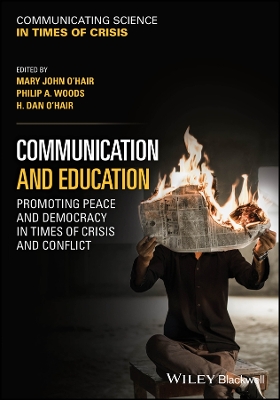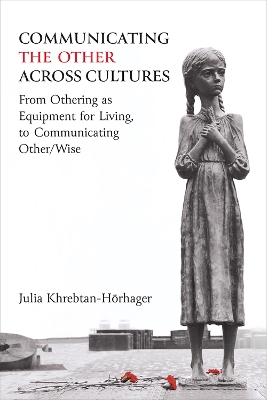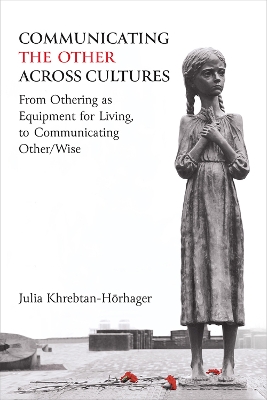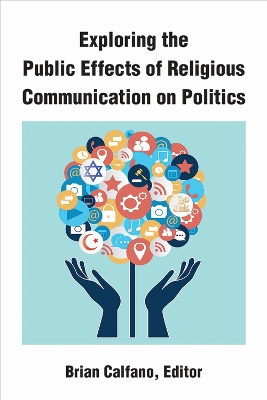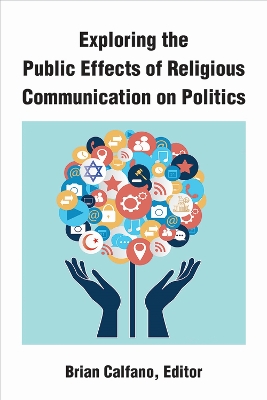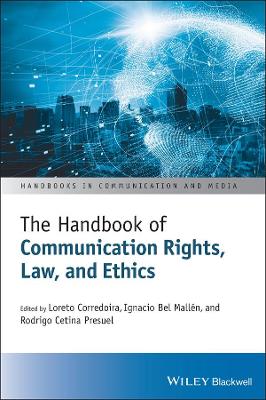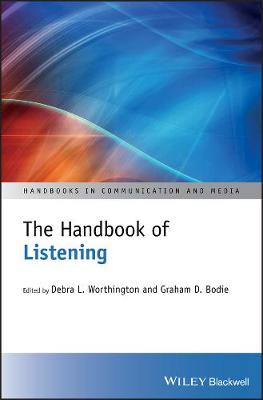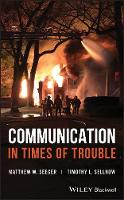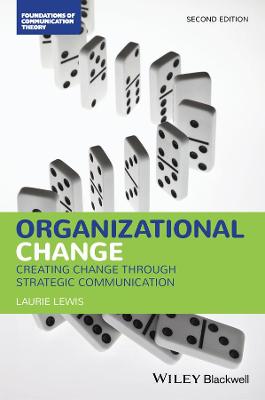Communication in Times of Trouble
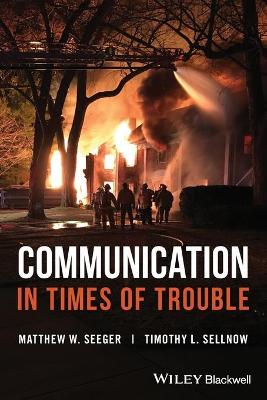 -15%
portes grátis
-15%
portes grátis
Communication in Times of Trouble
Sellnow, Timothy L.; Seeger, Matthew W.
John Wiley and Sons Ltd
04/2019
152
Mole
Inglês
9781119229254
15 a 20 dias
204
1 Introduction 1
What Is a Crisis? 2
What Do We Mean by Crisis Communication? 4
What Distinguishes Crisis Communication? 7
What Are Best Practices? 7
Summary 9
References 10
2 Process Approach: Take a Process Approach to Crisis Communication 11
What Do We Mean by "Communication Is a Process"? 12
What Does a Process Approach Mean for Crisis? 12
What Is a Crisis Life Cycle? 14
How Can These Stages Be Used by Crisis Communicators? 16
Why Should Communicators Participate in the Policy Formation Process? 17
Summary 19
References 20
3 Preevent Planning: Engage in Preevent Planning for Crisis
Communication 21
What Does Planning Involve? 21
What Is Crisis Communication Planning? 23
How Is a Plan Created? 24
How Is Risk Assessed? 25
What Is Included in a Crisis Plan? 26
Standard Elements of a Crisis Communication Plan 28
Implementing a Crisis Plan 29
Summary 30
References 31
4 Partnerships: Form Stakeholder Partnerships With Publics 33
Why Do Crisis Leaders Sometimes Avoid Communicating With Their Publics? 33
How Are Relationships With Publics Established? 34
What Is Dialog? 35
Why Do Some Agencies and Organizations Fail to Establish Dialog? 36
How Does Dialog Produce Partnerships With Publics? 37
Are There Times When Dialog Should Be Avoided? 38
What Roles Can Publics Play in Their Partnerships With Organizations and Agencies? 39
Summary 41
References 42
5 Public Concern: Listen to and Acknowledge Concerns of Publics 45
How Do Publics Respond to Risks? 46
What Communication Challenges Do Hazards Create? 46
What Communication Challenges Does Outrage Create? 49
How Should Agencies and Organizations Acknowledge the Concerns of Publics? 50
How Do Organizations and Agencies Anticipate Which Issues Are Likely to Produce Public Outrage? 51
How Can Organizations Communicate to Prevent and Manage Outrage? 52
Summary 54
References 55
6 Honesty: Communication With Honesty, Frankness, and Openness 57
Why Is It So Important to Be Honest? 58
What Does It Really Mean to Be Honest? 60
What Are Some Challenges to Being Honest During a Crisis? 62
How Is Openness Achieved During a Crisis? 64
Summary 66
References 67
7 Collaboration: Collaborate and Coordinate With Credible Sources 69
Who Are the Credible Partners for an Organization? 70
What Do Collaboration and Coordination Mean? 72
Why Are Collaboration and Coordination So Important? 75
How Can an Organization Create Collaboration and Coordination? 76
It Is Possible to Coordinate and Cooperate With Hostile Groups? 76
Summary 77
References 78
8 Media Access: Meet the Needs of the Media and Remain Accessible 79
Why Is Media Access Important? 80
What Does Accessibility Mean? 82
How Does an Organization Maintain Accessibility? 83
What Happens If Organizations Are Not Open During a Crisis? 85
Will the Media Tell a Negative Story Regardless of the Facts? 86
Summary 86
References 87
9 Compassion: Communicate With Compassion 89
What Is a Compassionate Response to Crisis? 90
Who Is the Best Organizational Spokesperson for Expressing Compassion? 92
When Is Expressing Compassion Most Important? 93
Should an Organization Express Compassion If Blame Is Uncertain? 94
How Should an Organization Express Compassion If Blame Is Certain? 94
How Should Spokespersons Express Compassion Through Social Media? 95
What Role Does Culture Play in the Expression of Compassion? 96
Summary 97
References 98
10 Uncertainty: Accept Uncertainty and Ambiguity 101
What Causes Uncertainty for Publics? 101
How Do Publics Respond to Uncertainty? 103
What Kind of Information Do Publics Seek to Reduce Their Uncertainty? 104
How Can Organizations Avoid Overreassuring Their Publics? 105
What Are Some Other Ways to Manage Uncertainty? 106
What Are the Ethical Standards for Managing Uncertainty? 108
Summary 110
References 111
11 Empowerment: Communicate Messages of Empowerment 113
How Can Messages Empower Publics? 113
What Are the Components of an Empowering Message? 114
How Can Risk and Crisis Communicators Help Their Publics Internalize the Risk? 114
How Should Messages Be Distributed to Publics? 116
How Much Explanation of the Crisis Is Necessary? 117
How Should Recommendations for Self-Protective Actions Be Communicated? 118
What If Publics Are Given Competing Recommendations for Empowerment? 120
What Is the Role of Empowering Messages Outside the Acute Phase of Crisis? 121
Summary 122
References 123
12 Conclusion: Implementing the Best Practices 125
Are Crises Really Occurring More Often and Are They Getting Worse? 126
How Can an Organization Repair Its Damaged Image? 128
Are There Ever Positive Outcomes to a Crisis? 130
What Are the Challenges to Implementing the Best Practices? 132
How Can the Best Practices Approach to a Crisis Be Used? 133
Summary 134
References 135
Index 137
1 Introduction 1
What Is a Crisis? 2
What Do We Mean by Crisis Communication? 4
What Distinguishes Crisis Communication? 7
What Are Best Practices? 7
Summary 9
References 10
2 Process Approach: Take a Process Approach to Crisis Communication 11
What Do We Mean by "Communication Is a Process"? 12
What Does a Process Approach Mean for Crisis? 12
What Is a Crisis Life Cycle? 14
How Can These Stages Be Used by Crisis Communicators? 16
Why Should Communicators Participate in the Policy Formation Process? 17
Summary 19
References 20
3 Preevent Planning: Engage in Preevent Planning for Crisis
Communication 21
What Does Planning Involve? 21
What Is Crisis Communication Planning? 23
How Is a Plan Created? 24
How Is Risk Assessed? 25
What Is Included in a Crisis Plan? 26
Standard Elements of a Crisis Communication Plan 28
Implementing a Crisis Plan 29
Summary 30
References 31
4 Partnerships: Form Stakeholder Partnerships With Publics 33
Why Do Crisis Leaders Sometimes Avoid Communicating With Their Publics? 33
How Are Relationships With Publics Established? 34
What Is Dialog? 35
Why Do Some Agencies and Organizations Fail to Establish Dialog? 36
How Does Dialog Produce Partnerships With Publics? 37
Are There Times When Dialog Should Be Avoided? 38
What Roles Can Publics Play in Their Partnerships With Organizations and Agencies? 39
Summary 41
References 42
5 Public Concern: Listen to and Acknowledge Concerns of Publics 45
How Do Publics Respond to Risks? 46
What Communication Challenges Do Hazards Create? 46
What Communication Challenges Does Outrage Create? 49
How Should Agencies and Organizations Acknowledge the Concerns of Publics? 50
How Do Organizations and Agencies Anticipate Which Issues Are Likely to Produce Public Outrage? 51
How Can Organizations Communicate to Prevent and Manage Outrage? 52
Summary 54
References 55
6 Honesty: Communication With Honesty, Frankness, and Openness 57
Why Is It So Important to Be Honest? 58
What Does It Really Mean to Be Honest? 60
What Are Some Challenges to Being Honest During a Crisis? 62
How Is Openness Achieved During a Crisis? 64
Summary 66
References 67
7 Collaboration: Collaborate and Coordinate With Credible Sources 69
Who Are the Credible Partners for an Organization? 70
What Do Collaboration and Coordination Mean? 72
Why Are Collaboration and Coordination So Important? 75
How Can an Organization Create Collaboration and Coordination? 76
It Is Possible to Coordinate and Cooperate With Hostile Groups? 76
Summary 77
References 78
8 Media Access: Meet the Needs of the Media and Remain Accessible 79
Why Is Media Access Important? 80
What Does Accessibility Mean? 82
How Does an Organization Maintain Accessibility? 83
What Happens If Organizations Are Not Open During a Crisis? 85
Will the Media Tell a Negative Story Regardless of the Facts? 86
Summary 86
References 87
9 Compassion: Communicate With Compassion 89
What Is a Compassionate Response to Crisis? 90
Who Is the Best Organizational Spokesperson for Expressing Compassion? 92
When Is Expressing Compassion Most Important? 93
Should an Organization Express Compassion If Blame Is Uncertain? 94
How Should an Organization Express Compassion If Blame Is Certain? 94
How Should Spokespersons Express Compassion Through Social Media? 95
What Role Does Culture Play in the Expression of Compassion? 96
Summary 97
References 98
10 Uncertainty: Accept Uncertainty and Ambiguity 101
What Causes Uncertainty for Publics? 101
How Do Publics Respond to Uncertainty? 103
What Kind of Information Do Publics Seek to Reduce Their Uncertainty? 104
How Can Organizations Avoid Overreassuring Their Publics? 105
What Are Some Other Ways to Manage Uncertainty? 106
What Are the Ethical Standards for Managing Uncertainty? 108
Summary 110
References 111
11 Empowerment: Communicate Messages of Empowerment 113
How Can Messages Empower Publics? 113
What Are the Components of an Empowering Message? 114
How Can Risk and Crisis Communicators Help Their Publics Internalize the Risk? 114
How Should Messages Be Distributed to Publics? 116
How Much Explanation of the Crisis Is Necessary? 117
How Should Recommendations for Self-Protective Actions Be Communicated? 118
What If Publics Are Given Competing Recommendations for Empowerment? 120
What Is the Role of Empowering Messages Outside the Acute Phase of Crisis? 121
Summary 122
References 123
12 Conclusion: Implementing the Best Practices 125
Are Crises Really Occurring More Often and Are They Getting Worse? 126
How Can an Organization Repair Its Damaged Image? 128
Are There Ever Positive Outcomes to a Crisis? 130
What Are the Challenges to Implementing the Best Practices? 132
How Can the Best Practices Approach to a Crisis Be Used? 133
Summary 134
References 135
Index 137

